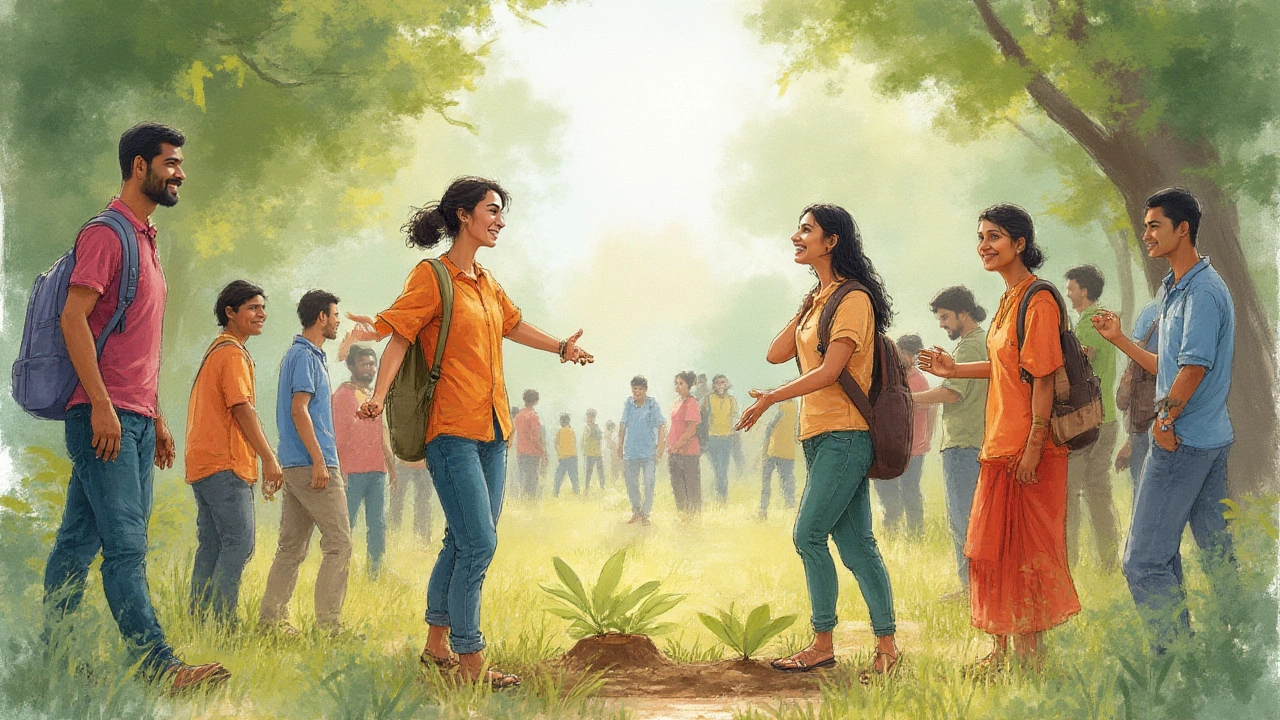If you’ve ever scrolled through social media and admired those people cleaning up parks or handing out food at shelters, you’ve probably wondered what holds everyone else back. Loads of organisations desperately need more hands, yet so many of us hesitate when it comes to volunteering. It’s easy to say ‘people are too busy’, but the real story runs a lot deeper. That gap—between wanting to help and actually showing up—remains surprisingly big, even in tight-knit communities like Bristol or bustling cities on the other side of the world. The excuses sound familiar, but they usually mask something more complicated going on underneath.
The Most Common Roadblocks to Volunteering
Let’s talk reality. If you search for ‘Why don’t people volunteer?’, time pops up everywhere. It makes sense: people are working longer hours than ever. A 2024 study by NCVO (the National Council for Voluntary Organisations) found that 43% of UK adults say ‘lack of time’ is their main barrier—and that’s just the start. Time is only the surface. Underneath, there are things people don’t often admit out loud, like feeling socially awkward, doubting whether their efforts matter, or simply feeling overwhelmed by the idea of starting something new. Think about how it feels joining a new gym for the first time; showing up to a group of tight-knit volunteers can be even more intimidating.
Then there’s the big elephant in the room: burnout. You might have heard friends who started out super enthusiastic say they got loaded with responsibility fast, or that their efforts just blended into the background. Volunteering can sometimes feel like a treadmill that never really stops to celebrate wins. Add that to life stress—jobs, families, or, frankly, even wanting to binge-watch your new favourite series—and it’s easy to see why enthusiasm fizzles.
Another huge factor no one loves to admit is money. Volunteering isn’t paid, of course, but sometimes it even costs money—think bus fares to the food bank or spending out on lunches during long shifts. According to Volunteer England, 21% of non-volunteers worry about direct costs. And if you’re already counting pennies, offering free labour can feel impossible. And sometimes it’s less obvious: a single parent can’t say yes to a Saturday event unless childcare is sorted.
Confidence crops up, too. Loads of us wonder, ‘Am I even qualified to help?’ or ‘What if I mess something up and look silly in front of people?’ Volunteering can be full of unfamiliar situations, and nobody likes feeling clueless. That’s why so many sign up in groups, and why friendly induction sessions make such a difference. Also, some people worry they’ll get stuck with tasks they hate—if you’re picturing lots of heavy lifting, or having awkward chats, it’s human to hesitate.
There are also cultural and social reasons, especially if you feel you won’t “fit in” with the current volunteering crowd. Bristol’s charity sector still struggles to attract people from every background. Language barriers, discrimination, or simply never seeing anyone like you at the info session, can all feel like a clear ‘Don’t bother’ sign even if unintentional. Now toss in anxiety about safety (especially in some types of outreach), and the list gets longer still. Busy parents, for example, mention safety concerns as a common worry in neighbourhood surveys.
Let’s not forget the last overlooked factor: not knowing where to start. With so many platforms, websites, and organisations, it becomes a maze. A lot of people give up before even trying—struggling to find a cause that matches their values, location, and schedule, or fearing they won’t be able to make an impact anyway. So, it’s no surprise so many default to doing nothing instead.
It’s easier to skip out on volunteering when none of your friends do it, and there’s no buzz about making a difference. Peer pressure isn’t always a bad thing! A 2023 survey from Youth Action found that when people received a personal ask from someone they knew, they were three times more likely to sign up. So, the right nudge matters more than you’d think.
| Reason | Percent of Adults (UK, 2024) |
|---|---|
| Lack of time | 43% |
| Concerns about cost | 21% |
| Feeling unqualified | 18% |
| Lack of confidence | 12% |
| No personal invitation | 10% |
| Don't know where to start | 23% |

Changing the Game: Making Volunteering Feel Possible
If you ask me, we don’t need more guilt trips to get people volunteering. It’s about making it as hassle-free and welcoming as possible. My friend Sam tried to volunteer with an animal shelter here in Bristol after getting a nudge through her running group WhatsApp. At first, she was sure it would mean a huge time commitment. But it turned out they offered two-hour weekend shifts. For Sam, realising she could help without giving up her own hobbies made all the difference.
One solution is smashing that ‘all or nothing’ myth. There’s this misconception that to be a ‘real volunteer’, you have to give every spare moment, sign away your weekends, or basically live at the community centre. Loads of charities now offer micro-volunteering—quick bursts of help, sometimes from your own sofa (think writing postcards to elderly residents or creating social media posts for a fundraiser). Volunteer opportunities are genuinely more flexible now than just a few years ago. NCVO said in their 2025 report that volunteering gigs requiring under 10 hours per month exploded by 35% in just one year.
Also, removing guesswork helps. The best volunteer coordinators don’t assume you know the ropes. Clear, friendly welcome emails, short introductory chats, and not drowning newbies in paperwork on day one make a huge difference. A good first impression can turn a nervous maybe into someone who comes back every week. Support matters even more for people with disabilities or who speak English as a second language; simple adjustments—like accessible venues or translated welcome packs—open doors for so many who used to get left out.
Money can be a tougher knot to untangle, but smart charities cover transport costs, provide snacks, and share kit. Last Christmas, one Bristol food bank sent out travel grants so volunteers didn’t have to weigh up between helping and their bus pass. Even little touches—like a coffee voucher after a shift—show appreciation in real, practical ways.
Peer support works wonders. The friend-effect is real. When people volunteer together or when volunteer leaders make introductions, everyone relaxes a bit. Social media is a secret weapon here: seeing friends’ stories or pictures in action tugs way more people in than a poster ever could. Volunteer Bristol noticed that team projects with a clear, fun purpose—like litter-picking contests with prizes—attract groups who may never have shown up alone. And if there’s a regular WhatsApp group or occasional meet-up for a pint afterwards, even better.
Knowledge is power, especially with the ‘am I qualified?’ worry. Skills-based volunteering gets people off the fence. Ever had a friend who’s good at graphic design or fixing bikes but never thought their talents would count as volunteering? Spotlighting roles beyond ‘simply’ serving soup helps people see where they fit. And, when organisations shout about the real impact volunteers have (think before-and-afters, testimonials, or a simple update on the volunteer Facebook group), motivation rises. We all want to know our time made a dent, even if it’s small.
Volunteering fairs still matter. When you can chat face-to-face rather than fill out endless forms online, it’s easier to say yes. And for people who don’t see themselves reflected, charities can do better—showing diverse faces in their comms, providing outreach in different languages, and being upfront about safety or making reasonable adjustments builds trust. When people feel seen, they join in.
Transparency makes life easier, too. The best programmes are straight about what’s expected right away: whether you’ll be lifting boxes, making phone calls, or spending hours in a dusty hall. The more realistic the taster session, the less likely people are to feel misled or overwhelmed.
Sometimes just knowing the stats can take the edge off. According to the UK’s 2024 Community Life Survey, the majority of first-time volunteers only helped out 1-2 hours per month on average—and still made meaningful connections and impact. It isn’t about clocking in 100 hours a year. It’s about making real, human moments, however small.

Tips and Inspiration for Getting More People Involved
Ready to get people interested in volunteering—or to get started yourself? Sometimes, all it takes is one well-placed nudge. No single tip will magically transform everyone into a serial volunteer, but a handful of practical changes can tempt more people off the sidelines. Here are some ideas that have helped people actually get going, based on what has worked around Bristol and far beyond.
- Start with a personal invite. Most people are much more likely to join if they’re asked directly by someone they know. If you volunteer already, be the friend who asks.
- Choose flexible roles. Even micro-volunteering—like a weekend park litter-pick—counts. Don’t assume you need to commit hours and hours.
- Go with a buddy. Everything feels less daunting if you start with a friend. Some local groups even encourage ‘plus one’ sign-ups for first-timers.
- Try before you commit. Taster sessions let you ‘sample’ volunteering without locking anything in. Keep things low-pressure at first.
- Ask about expenses. If travel or kit costs worry you, lots of places will cover basics with a simple ask.
- Focus on your skills. Whether it’s admin, playing football, or fixing bikes, your talents are wanted somewhere. Skills-based roles are often easier to stick with.
- Celebrate efforts. Sometimes, all people need is a thank you—or to see their work makes a difference. Share wins, big or small.
- Mix it up. If you’re part of an organisation, shake up the roles: swap tasks, offer socials, and keep things from getting stale.
- Break down the process. Streamline sign-ups and offer clear info. The easier it is, the more likely people are to jump in.
- Promote diversity. Make sure people see they’ll be welcome, whatever their age, background, or story.
The real trick is to make volunteering doable, sociable, and worth people’s while. My dog Luna comes with me to some park clean-ups. When people see it’s not about perfection, just doing your bit, the fear tends to melt away. Whether you’re thinking of joining in for the first time or helping others past the usual hurdles, remember: small changes in how we ask for help can make volunteering part of everyday life, not some mountain to climb.
